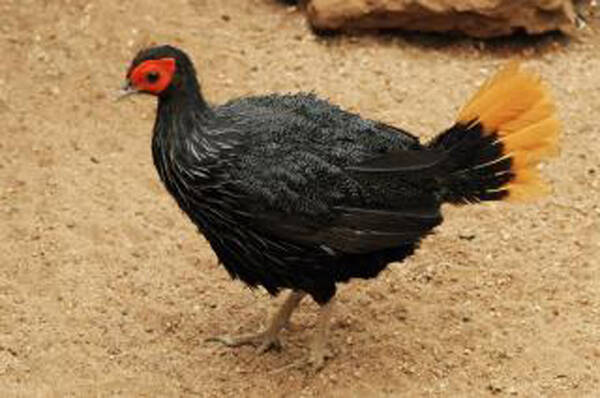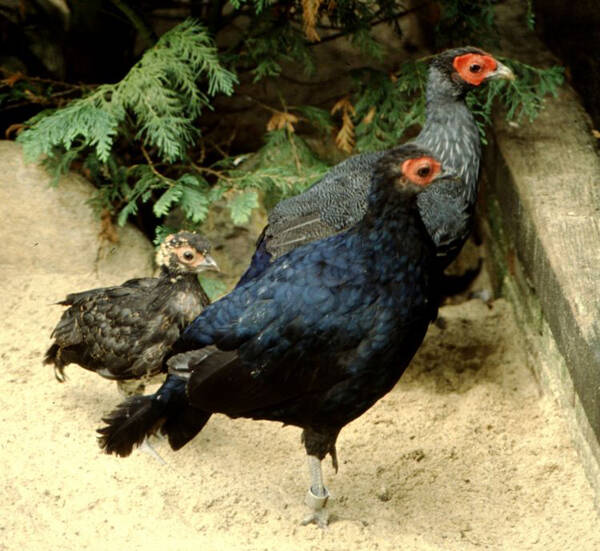Lophura pyronota
IUCN
LCBasic Information
Scientific classification
- name:Lophura pyronota
- Scientific Name:Lophura pyronota,Bornean Crestless Fireback
- Outline:Landfowl
- Family:P.genus P.family
Vital signs
- length:42-51cm
- Weight:No textual research information is available
- lifetime:No textual research information is available
Feature
Has striking scarlet facial skin
Distribution and Habitat
It is found in Brunei Darussalam, Indonesia and Malaysia.
It inhabits lowland forests, including native and well-restored enclosed evergreen forests. It occurs in evergreen, semi-evergreen forest, mixed forest, bamboo forest, brush and so on.
Appearance
The male is 47-51 cm long, and the female is 42-44 cm long. It is a black pheasant with a short, caramel-colored tail. Like all firebacks, the face has impressive decoration and plays an important role in courtship, with striking scarlet facial skin in this species.
The male's plumage is a metallic purple-black, with fine silvery gray on the upper and sides, and a caramel tail. The back is dark red with coloration similar to the hot embers of a flame, hence the name of the species. The throat, head, and back of the face are black, the chest, neck, and upper back are mostly fine curved gray stripes, and the tail is black and long and curved. The middle and back of the back are colorful, yellow, purple and blue. In courtship, the male unfurls the red crest of his face and rises at the same time to form two small fleshy horns.
The female is brown, with a glossy black-purple to blue-green back, a gray-brown head, and a hazel throat. The wings and tail feathers are black.
The
Details
Bornean Crestless Fireback (Lophura pyronota), a single species without subspecies differentiation. It was once a subspecies of Pheasant's Pheasant, but was classified as a separate species in 2014.

Bornean pheasants are often found alone or in pairs. It is most active in the early morning or evening, less active at noon, and more perches in trees at night. When the activity is often swagger, act alert, run quickly after fright, tail feathers show slightly, to run to a certain distance and then alert to observe the trend, sometimes stop and go, look outside. There is usually no inherent territory and range of activity, and no territorial sexuality, even during reproduction.
Borneo's fireback is alert and timid, and runs to the mountains when frightened. Generally rarely take off, but also fly up the tree in an emergency. It usually flies from the night dwelling tree to the ground after the dawn. It's only when it gets dark that we start to roost.
Bornean firebacks often follow animal trails (especially buffalo) and head to the water to drink in the early morning. It is omnivorous and feeds mainly on berries, termites, various fruits, roots and seeds. They also eat insects, beetles, ants, snails, earthworms and other animal foods.

The mating system in the Bornean pheasant is irregular, with single males or groups of equal numbers of adult males and females. Mating is considered pluralistic. Each clutch lays 3-6 eggs and incubates for 24 days. The life history and patterns of this bird are not fully understood, but it is known that females can enter the breeding period under three years of age.
The main threat to Borneo's fireback is habitat loss, degradation and fragmentation due to large-scale commercial logging. Even in some protected areas, as well as extensive cultivation of rubber and oil palm plantations, lowland forests are disappearing at a very rapid rate (Kalimantan province lost almost 25% of its evergreen forest area between 1985 and 1997). The reason for the species' decline is a variety of factors, including illegal logging and the escalation of land conversion, the significant problem is that selective logging of forest reserves (rather than the reserves themselves) leads to habitat degradation, including degradation of any unknown characteristics that affect the species' habitat selection, and exposes the forest to fire risk, reduced value, and future conversion to agricultural cropland. All this has put tremendous pressure on the Bornean fireback to find food.
Conservation action is reflected in the creation of several protected areas, including Gunung Mulu National Park in Sarawak; Tanjung Puting National Park in Kalimantan. Captive populations in Europe are not considered viable in the long term due to the decline in genetic diversity caused by the decline of wild species.
Listed on the International Union for Conservation of Nature (IUCN) 2016 Red List of Threatened Species ver 3.1 - Vulnerable (VU).
Protect wild animals and eliminate wild meat.
Maintaining ecological balance is everyone's responsibility!








